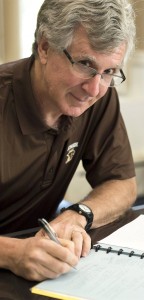
President John Simon, Lehigh’s 14th president, sits at his desk on Friday, Aug. 28, 2015. President Simon assumed his role as Lehigh begins celebrating its sesquicentennial. (Chris Barry/B&W Staff)
John Simon, Lehigh’s 14th president, posted his first Instagram 33 weeks ago and has posted 360 photos since, or an average of almost 11 photos a week. Simon has used the app as a way to learn about and connect with the Lehigh community.
Q: Your Instagram has gained a lot of popularity. What was the mindset in creating it?
John Simon: It sort of started with the OurLehigh project in that I wanted to use the transition time between appointment and starting here to learn about Lehigh as much as I could. I figured (it was) the best way to enable people to tell me what they wanted to tell me about the institution — their stories, their engagement. There were some great pieces that were submitted. It was a lot of fun. I learned a lot.
At the same time, I’m still learning what this job is and what this job is not. This job was not the chief academic officer job I had. There’s many different faces and connections to a wide range of constituencies. As I’m talking to members of each one of those groups, they don’t have a clue what the demands are on the job and the ways in which you need to connect and bring those different constituencies together. So that launched a conversation internally — how do you convey them? To me, the answer was some type of social media network.
There are a lot of them. Whether you want to tweet, whether you want to use Facebook or Instagram. I had a lot of friends that tweeted. A lot of presidents tweet, and I would say a lot of presidents accidentally tweet something that gets interpreted in a way different that what they (meant). There was a small handful of people using Instagram and I just decided it would be more effective to tell the story through pictures than 140 characters.
So I settled on Instagram and made a commitment to it. I’ve had surprising engagement from parents and prospective students. So it’s got a life bigger than what I thought it would have as a communication tool.
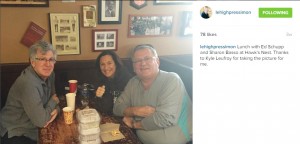
Courtesy of John Simon’s Instagram
JS: I think you have to do all of it. So, I’m stuck with the bunch of speeches, but I remember going to Town Hall before I came, and someone was tweeting out what was going on in Town Hall. It made me think that everyone is going to do social media and networking about you — it comes with the job. You might as well also have a message about what you’re doing and how you think about it and what groups you’re talking to and why, and what you’re thinking about the institution through that media.
So I think to not be engaged in that type of media is a huge mistake. I think half the letters I write don’t get read, or don’t get retained. So it may in some way be the most important way in which I connect with the university community that’s here in Bethlehem.
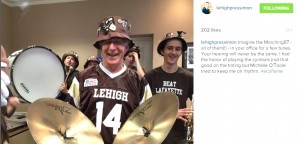
Courtesy of John Simon’s Instagram
Q: Do you think that in this technological era, social platforms reach and engage people better than face-to-face interactions?
JS: I come from a generation that’s very face-to-face. I think there are generational aspects in the answer to your question. I think a lot of business, politics — whatever you want to think about in the world — a lot of it will still really engage face-to-face conversation. But I think the electronic means of working together, getting to know each other, finding out what people are really like, is here to stay. And I think it’s positive. It’s got its pros and cons like everything else.
I gave a convocation speech at UVA once and talked about the need to go global. The relevant piece is that I talked about my relationship with a guy in Japan. He and I have written probably 20 scientific papers together. I’ve met him once. I consider him a friend, I know him really well. He knows me really well. Entirely through electronic communication, all of that has taken place over a period of 15 years. So you can have very meaningful relations with people, you can do great work with people, or the whole acknowledging of each other is facilitated by electronic media.
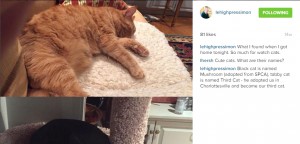
Courtesy of John Simon’s Instagram
Q: Coming from a face-to-face generation, did you have a specific instance that opened you up to the world of social media?
JS: I have two sons. One is a freshman in college, one’s a senior in high school. I have one who doesn’t engage with it at all, and one who is just totally engaged with all the different media, so I’ve seen both sides of it in your generation. And, to me, the biggest hurdle is one of privacy, and this perception that our generation cares about cares a lot about anonymity and privacy, and there’s less concern about that.
Now that I’ve been using it for eight or nine months pretty seriously, I don’t think about those issues that you would expect to how I conduct my life as president of the university. And you can see it. I watched Facebook change. There was no protected information in the earlier days, and then you got to protect and decide who would see certain information. So you know it sort of is moving to some compromise and not enabling total access, and kind of limiting access.
Q: Can you name a time that social media surprised or inspired you with what it could do?
JS: I think this is the living example. I think Silagh White, (Lehigh’s director of arts engagement and community relations and professor at the Baker Institute), gave me a walking tour of off-beat arts venues in South Bethlehem in OurLehigh. It was about a four or five minute video, and I remember some specific ones. I felt, after watching that, that I had a serious taste of the interesting opportunities to do right here right in the South Bethlehem area, in just four minutes of a walking tour. I think there are a lot of examples like that.
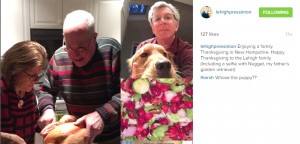
Courtesy of John Simon’s Instagram
So I’ve been trying to understand (Instagram likes). You’ve got a lot of people that follow, and they can like or not like a photo, and it’s really interesting to think about what motivates what people like and what people don’t. The number one photo on my Instagram right now is the moon rising over Linderman. So it’s interesting.
Originally I was also thinking that there are multiple ways you can spend your time. And there are several high-profile events that you may or may not be able to attend. But absence is noticed, or if you travel for almost two weeks — like essentially I am doing — where absence from campus leads to absence at student events and stuff like that, and people notice that. But if they know where you are, and what you’re doing, and why you’re doing it on behalf of the university, there’s no issues associated with the absence. So part of it I look at it as a communication tool, that it’s going to be much more.




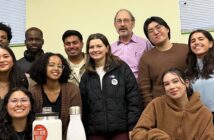
Comment policy
Comments posted to The Brown and White website are reviewed by a moderator before being approved. Incendiary speech or harassing language, including comments targeted at individuals, may be deemed unacceptable and not published. Spam and other soliciting will also be declined.
The Brown and White also reserves the right to not publish entirely anonymous comments.